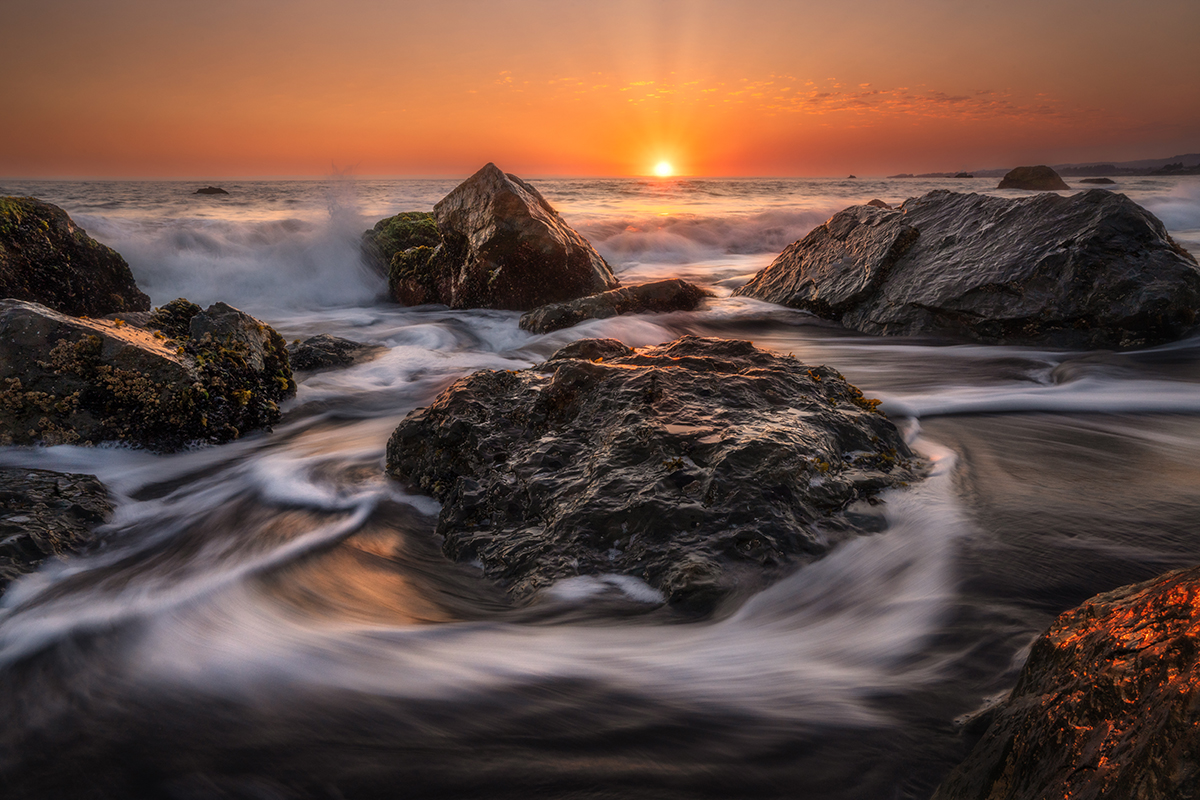Re-creating a Moment
Beth Mancuso draws out the emotion of the landscapes in front of her camera with the Tamron 17-28mm F/2.8 ultra-wide-angle lens.
Share the article:
More Photo Tips | Video Gallery | Photo Gallery | Enewsletter sign-up
By Jenn Gidman
Images by Beth Mancuso
Beth Mancuso first picked up a camera when her kids were born so she become the family photographer to save some money on portraits. That experiment led to her running a portrait photography business for more than a decade. “Then I remarried and started traveling and camping with my husband, and I fell in love with landscape photography,” she says. “I thought, ‘How can I make money doing this?’”
Fast forward to today, and the photographer from Zimmerman, Minnesota, is now leading online and one-day photography workshops in Minnesota and Wisconsin, as well as multiday photography retreats across the US for female photographers. “When I take my own landscape photos, I want the viewer to feel like they’re transported to that place with me,” Beth says. “Sometimes when you’re at a location and take a quick photo, it doesn’t seem to do the beauty of that place justice. By mastering light, motion, and details, I aim to re-create what I’m seeing and feeling so that I can share that visceral experience with others.”
One lens that Beth uses to help her achieve her nature and landscape photos is the Tamron 17-28mm F/2.8 Di III RXD ultra-wide-angle zoom lens for her Sony mirrorless camera system. “When I first started photographing landscapes, I was using a 14mm prime, and I became frustrated with the distortion,” she says. “Then I stumbled upon the Tamron 17-28, and now it rarely leaves my camera. Between that lens and the Tamron 28-200mm Di III RXD, I have coverage for everything I want to shoot. But the 17-28 is my go-to lens—that F/2.8 aperture is ideal for when I’m shooting in lower light, and my photos always come out beautifully sharp. Plus, at just 3.9 inches long and weighing only 14.8 ounces, it’s so easy to carry around all day.”
Beth shoots mostly handheld, other than when she’s going for photos with a slower shutter speed, like when she’s taking pictures of waterfalls. “I think landscape photographers often set their camera on their tripod and forget to vary its height or position,” she says. “When I’m teaching my workshops, I tell my students to move throughout the scene so that you’re always finding different angles.”
What catches Beth’s eye when she’s in the midst of her meanderings: patterns in nature, leading lines, and color. “Texture and detail are also wonderful,” she says. “And I love motion, especially when it comes to photographing water. I tend to seek out lakes, rivers, and oceans, because by just varying my shutter speed in tiny increments, I can completely alter what kind of photo I capture.”
Read on to see how Beth has used her Tamron 17-28mm ultra-wide-angle zoom during some recent photographic adventures.
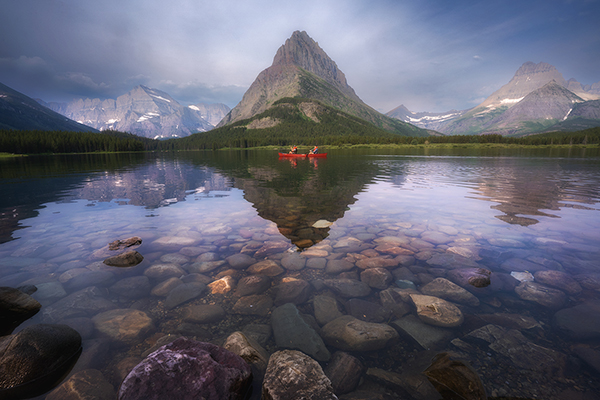
17-28mm (17mm), F/22, 1/60 sec., ISO 500
Click image to view larger
This photo of the canoes in the lake was taken at Montana’s Glacier National Park. I originally was concentrating on trying to capture the reflection, but then those people paddled into the scene. I was shooting rapid-fire because I wanted to photograph them right as they arrived in the center of the mountain and its accompanying reflection. I love how they added a sense of scale to the photo, but also how they managed to turn the image into more of a center composition shot, which can be tricky to do sometimes.
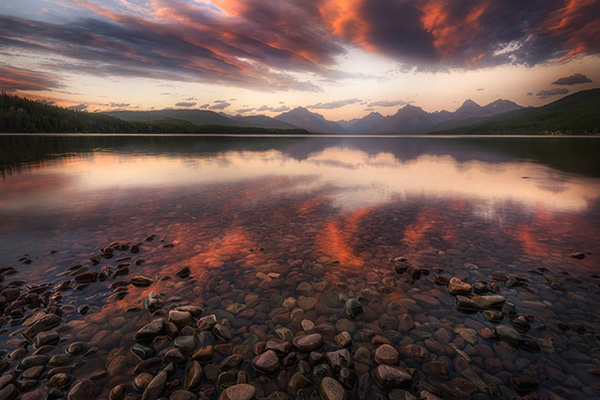
17-28mm (17mm), F/16, 1.3 sec., ISO 50
Click image to view larger
Lake McDonald is also in Glacier National Park. It’s the largest lake in the park. The sun was setting behind me, but sometimes, when the sun is heading down toward the horizon, it’ll light up the entire sky in brilliant colors. This happened to be one of those nights. I was sitting there with my tripod on the beach, watching it all unfold, and it was only lit up like that for about a minute before it disappeared. I had to work quickly to capture the light show and the reflection in the water.
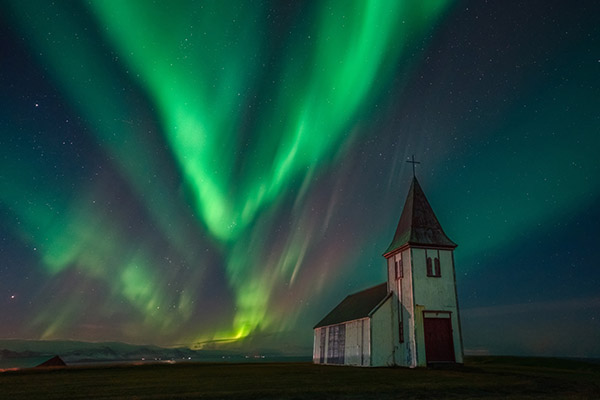
17-28mm (23mm), F/2.8, 4.0 sec., ISO 2000
Click image to view larger
I recently got back to the States from my second trip to Iceland. I took this photo of the northern lights on the Snaefellsnes Peninsula, which features everything from black sand beaches and volcanoes to waterfalls, coastal cliffs, and wide open fields with historic buildings. I locked my focus on this church and had my intervalometer going every 3 seconds. It was amazing how quickly the lights changed. The sky would become super-bright, then change positions. It was incredible to witness.
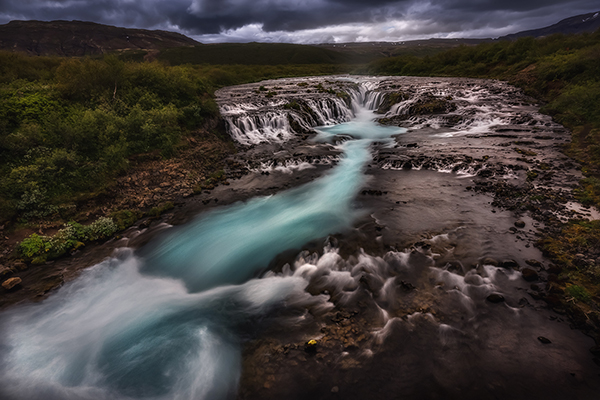
17-28mm (20mm), F/16, 1.6 sec., ISO 640
Click image to view larger
The Bruarfoss waterfall is located in Iceland’s Golden Circle. We took the hike up there one afternoon when it was somewhat stormy. There’s a bridge that spans across the river there, so I positioned myself off in one corner, set up my tripod, put on a filter, and started shooting. I tried to match up the way that the water flowed so that it takes your eyes through the frame and all the way to the waterfall.
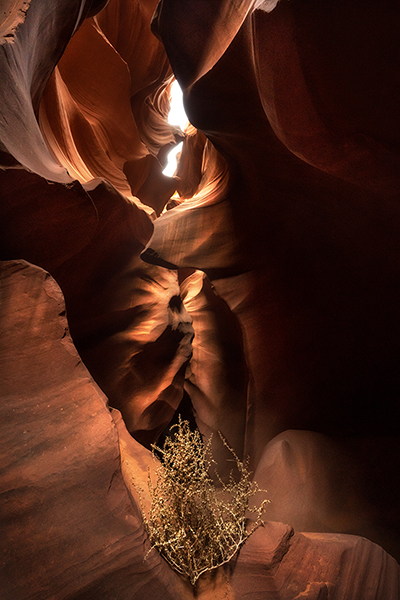
17-28mm (17mm), F/8, 1/160 sec., ISO 2500
Click image to view larger
This image in Arizona’s Antelope Canyon was tricky to capture. To access the canyon, you have to take a paid tour, and you’re not allowed to bring a tripod in. You have to turn your ISO way up, because there’s such a variation between light and dark in the canyon. When I spotted this piece of tumbleweed, I thought, “Oh, that’s different!” You don’t see a lot of tumbleweed down there, so I knew I had to take the photo, with the tumbleweed serving as my unusual foreground element.
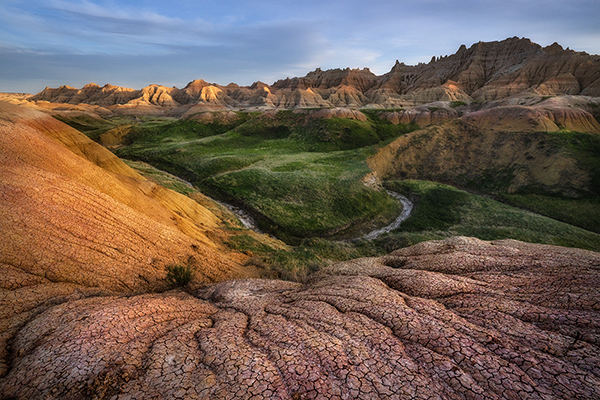
17-28mm (17mm), F/18, 1/200 sec., ISO 800
Click image to view larger
This section of Badlands National Park is my favorite part of the park. It’s so colorful, with yellow, red, and tan bands of color, as well as green in the spring. That’s the only time you’ll see green in the Badlands; it dries up pretty quickly, due to the lack of water. I liked the natural S-curve in this scene, and how the light was hitting the texture of the dried-up riverbed. I had to place my camera low so I could capture all of that detail.
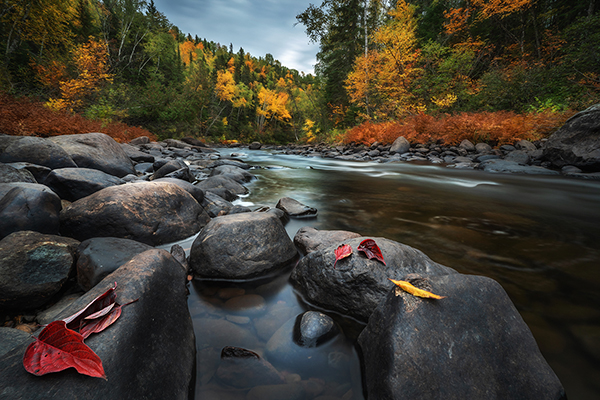
17-28mm (17mm), F/13, 30.0 sec., ISO 320
Click image to view larger
When I’m closer to home, I spend a lot of time with my camera on the North Shore here in Minnesota. It’s especially pretty in the fall, with plenty of waterfalls, rugged cliffs, and, of course, Lake Superior. The leading lines of the river here drew me in, directing my eye through the scene. The rocks and colorful leaves seemed like perfect foreground elements to incorporate.
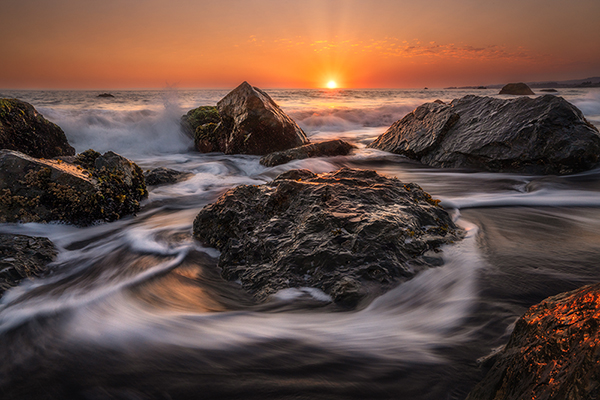
17-28mm (23mm), F/22, 1/4 sec., ISO 320
Click image to view larger
This Pacific Northwest sunset shot was taken at the beach in front of our hotel in Smith River, California. Whenever I photograph water, I always try to watch which way the water flows. I saw in this case that it was looping around the rock in the center, and I loved the motion of that, plus the glow of the sunset reflecting off the rocks. There’s a fine line when you’re trying to achieve that creamy look in the water with longer exposures: You don’t want it to get so silky that you lose all definition in the waves in the background.
To see more of Beth Mancuso’s work, check out her website and Instagram.
More Photo Tips | Watch Videos | Learn More About Tamron Lenses | Photo Gallery
